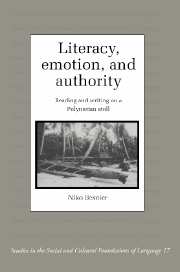Book contents
- Frontmatter
- Contents
- List of illustrations and tables
- Acknowledgments
- Transcription conventions and orthography
- 1 Introduction
- 2 The ethnographic context
- 3 The domains of reading and writing
- 4 Letter writing and reading
- 5 Letters, economics, and emotionality
- 6 Between literacy and orality: the sermon
- 7 Literacy, truth, and authority
- 8 Conclusion
- Notes
- References
- Index of Tuvaluan words
- General index
Transcription conventions and orthography
Published online by Cambridge University Press: 14 August 2009
- Frontmatter
- Contents
- List of illustrations and tables
- Acknowledgments
- Transcription conventions and orthography
- 1 Introduction
- 2 The ethnographic context
- 3 The domains of reading and writing
- 4 Letter writing and reading
- 5 Letters, economics, and emotionality
- 6 Between literacy and orality: the sermon
- 7 Literacy, truth, and authority
- 8 Conclusion
- Notes
- References
- Index of Tuvaluan words
- General index
Summary
The arguments developed in this book rest heavily on the empirical analysis of both written texts and transcripts of spoken discourse produced in the Polynesian language in common use on Nukulaelae Atoll, Tuvalu Group, Central Pacific. This approach foregrounds two questions of particular concern: how spoken discourse should be transcribed; and what orthographic conventions should be adopted in light of the fact that there is no standardized orthography for the language in question. I have adopted a number of conventions in answer to these questions, which are described here.
Transcripts and written texts
Transcribing spoken discourse is an analytic act, as many scholars have demonstrated (e.g., Edwards 1993, Gumperz and Berenz 1993, Ochs 1979a, Tedlock 1983); the selection of linguistic and extra-textual information to be included in the transcript from a very broad range of possibilities, as well as their visual presentation, involve decisions that predetermine how the transcripts are read and what categories become the focus of analytic scrutiny.
Many spoken excerpts cited in this book are not the object of detailed grammatical analysis, although I do pay attention to formal features in my analysis of the meaning of many excerpts. I have therefore adopted transcription conventions that represent a compromise between the fine-grained transcription system used in Conversation Analysis (e.g., Atkinson and Heritage 1984) and the selectively translated paraphrases with which social anthropologists are commonly satisfied.
- Type
- Chapter
- Information
- Literacy, Emotion and AuthorityReading and Writing on a Polynesian Atoll, pp. xiii - xxPublisher: Cambridge University PressPrint publication year: 1995



